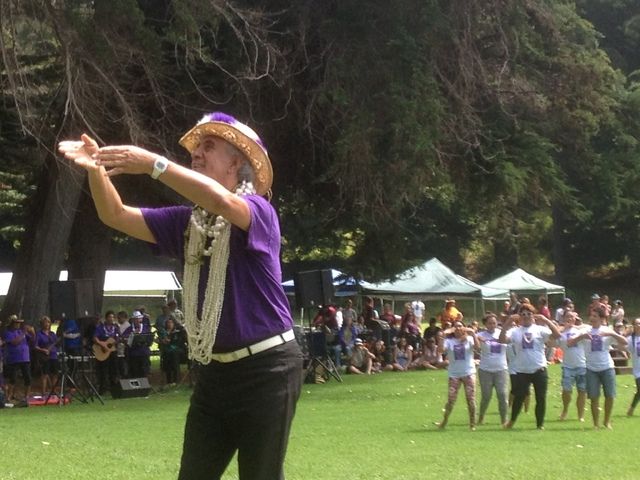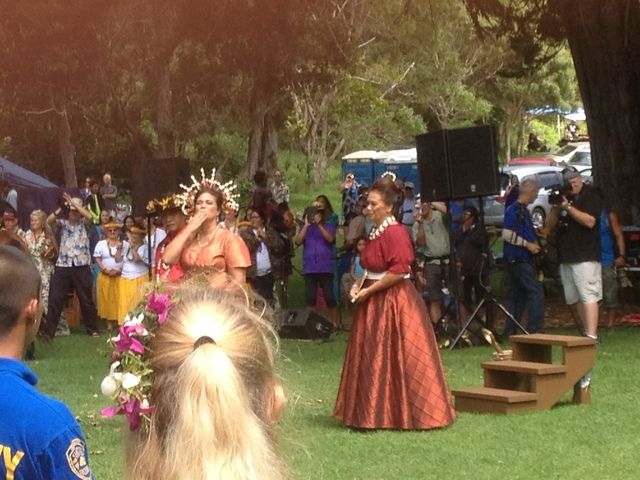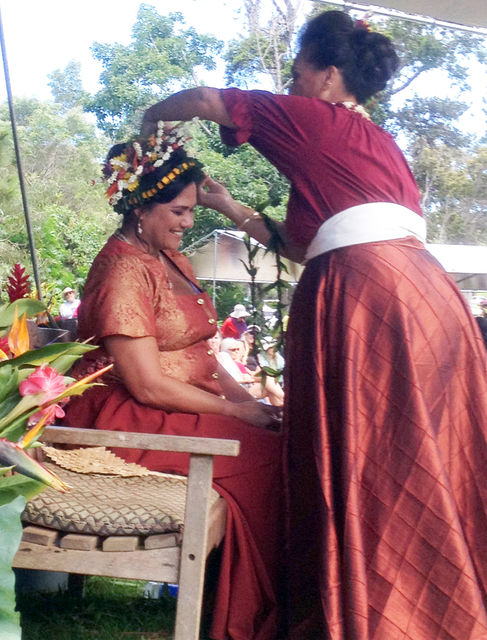KOKEE — The scene started as the horses came down the hill through the thicket of trees. Atop the lead horse, a queen. “Chicken skin,” is how Princeville resident Hob Osterlund described her reaction to seeing the reenactment of Queen
KOKEE — The scene started as the horses came down the hill through the thicket of trees.
Atop the lead horse, a queen.
“Chicken skin,” is how Princeville resident Hob Osterlund described her reaction to seeing the reenactment of Queen Emma Kalanikaumakaamano Kaleleonalani Naea Rook’s trek to Kanaloahuluhulu Meadow in Kokee, which on Saturday started with Nalani Brun, portraying the queen, coming down a hill through the trees to an open field where hundreds of guests awaited her arrival. “So regal, so beautiful, you get such a essence of the Hawaiian core. It’s so beautiful just to be able to witness.”
Hundreds of people trekked to the meadow to pay homage to the queen’s journey, which she took in 1871 because her husband, King Kamehameha IV, had talked about the scenic wonderland before his death.
When she arrived, Queen Emma told stories, took in the beautiful views, and watched her friends dance on a large, flat rock.
And Saturday, history came alive.
After Brun’s horse strode next to a cheering ring of admirers, she took her seat under a tent and watched as hula halaus from across the islands performed for her — nearly like 144 years ago.
Paying tribute is an important step to remembering your history, said Keahi Manea, kumu hula for Ka ‘Imi Na’ auao O Hawaii Nei Institute, who performed for the queen and her lady- in-waiting, Melissia Mae Aki Sugai.
“That’s where we came from,” she said. “They gave us what we have, they brought us here. We are the face of those people behind us. And it’s our responsibility to show the best face that we can because we owe it to them.”
Queen Emma began her 1871 pilgrimage to the meadow alone from Lawai, where she had a small cottage. By the time she reached Waimea she had 100 people with her.
The annual re-enactment celebration, Eo e Emalani I Alaka’I, also known as the Emalani Festival, is always held the second Saturday of October.
The crowd formed a ring around Emma’s tent, while hula halaus danced in the grass.
“We are real people and not just fairy tales,” Kumu Roselle Keli’ihonipua Bailey, the emcee of the event told the crowd, on the importance of sharing Kauai’s history.
“My feelings were and still are to bring the history alive and the people to the people who lived here,” she added. “Just looking around you see Hawaiians up here and local people up here. … So yes, the message is getting across. It’s a time to stand tall.”
There were also visitors, such as Kilino Marquez from New Mexico, who worked in a trip to Kokee on his vacation to take in the show.
The retired school superintendent said he lives in an area where Native American culture preservation is key, and an event like Saturday’s would be a good idea for organizers back home to promote in a similar fashion back there.
“We have some areas in our community where something like this can be organized,” he said, adding that the event was absolutely worth the trip up the canyon. “Language preservation is a big thing.”
Emalani Festival is sponsored by Hawaii Tourism Authority and the County of Kauai, and the Kekaha Host Community Benefits Program will match the total amount of funds that are raised. Funds will go to Hui O Laka for the maintenance of the Kokee Museum.
But the goal of the event, which started in 1990 with the inaugural queen, Maile Amorin, is more about reflection than anything else.
“We have an investment in this place, this legacy,” Manea said. “It’s a responsibility we feel.”




